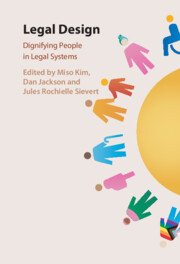Book contents
- Legal Design
- Legal Design
- Copyright page
- Dedication
- Contents
- Figures and Tables
- Contributors
- Foreword
- Acknowledgments
- Introduction
- I Why Legal Design
- II What Legal Design Can Do
- III How Legal Design Works
- IV Where Legal Design Goes
- 22 Legal Design Could and Should Be More Sociolegal
- 23 Navigating in a Post-Quantum Legal Design Landscape
- 24 Evaluation Capacity Building in Legal Design
- 25 The Peril and Promise of Certificates and Degree Programs in Legal Design
- 26 Repair and Resistance
- Conclusion
- Index
- References
22 - Legal Design Could and Should Be More Sociolegal
from IV - Where Legal Design Goes
Published online by Cambridge University Press: 19 December 2024
- Legal Design
- Legal Design
- Copyright page
- Dedication
- Contents
- Figures and Tables
- Contributors
- Foreword
- Acknowledgments
- Introduction
- I Why Legal Design
- II What Legal Design Can Do
- III How Legal Design Works
- IV Where Legal Design Goes
- 22 Legal Design Could and Should Be More Sociolegal
- 23 Navigating in a Post-Quantum Legal Design Landscape
- 24 Evaluation Capacity Building in Legal Design
- 25 The Peril and Promise of Certificates and Degree Programs in Legal Design
- 26 Repair and Resistance
- Conclusion
- Index
- References
Summary
Legal design could and should be more sociolegal. Sociolegal research can offer conceptual frameworks, empirical methods and data, and normative direction to legal design. At the same time, designerly methods can enhance the abilities of sociolegal researchers to make and communicate a sense of things to, with and for themselves, academics in other disciplines, and the wider world. So, if legal designers were to engage more deeply and systematically with sociolegal research and researchers, benefits could flow to legal design, to cross-disciplinary research, and to the wider world.
- Type
- Chapter
- Information
- Legal DesignDignifying People in Legal Systems, pp. 343 - 354Publisher: Cambridge University PressPrint publication year: 2024

